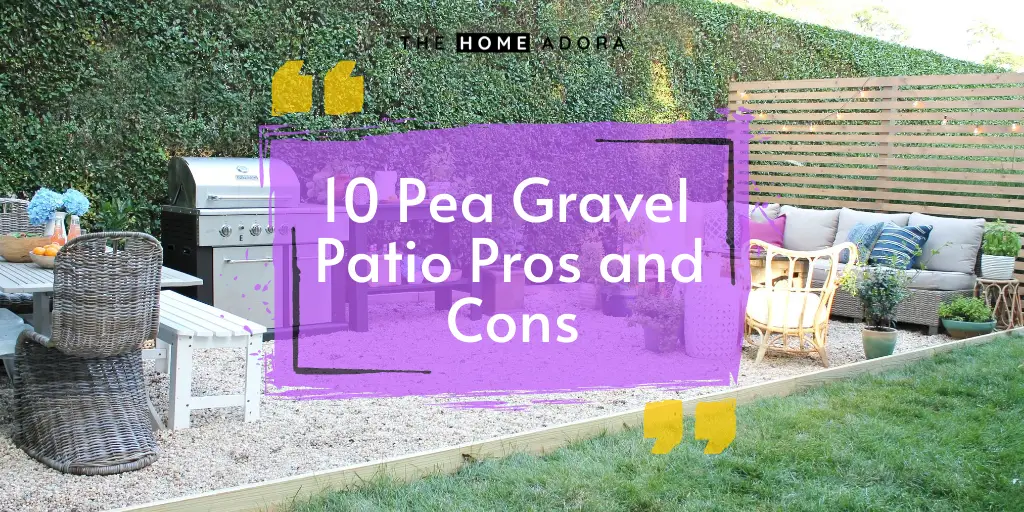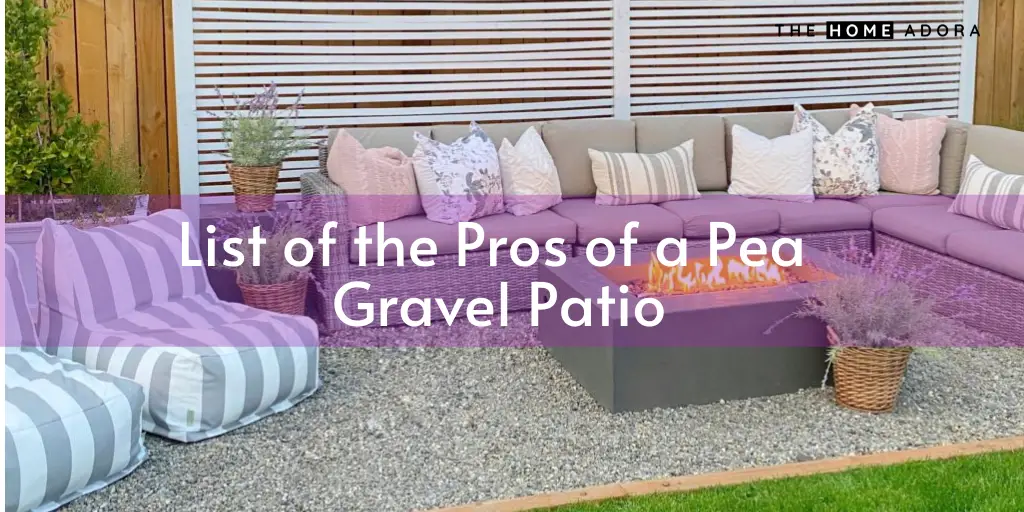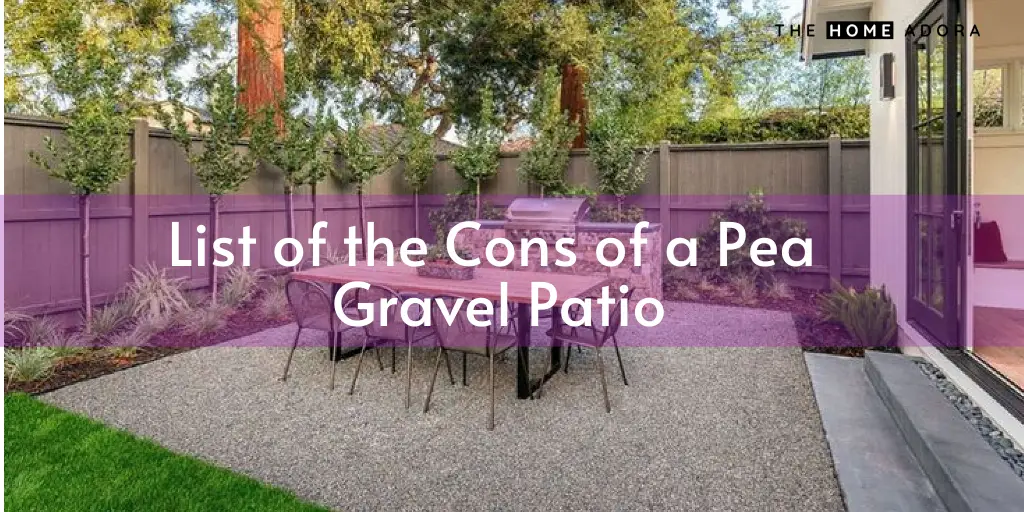Patios provide a space for homeowners to relax and entertain outdoors. There are many patio materials to choose from, but one of the more popular options is pea gravel.
Pea gravel is a small, smooth stone that is commonly used by individuals and contractors for gardening, landscaping, and outdoor building. It gets its name from the product’s size, which is akin to green peas. It can be used in practically every landscaping condition, including lawn accents, groomed walks, drainage help, and even as a driveway.

If you’re considering adding a pea gravel patio to your backyard, you’ll need to first figure out the size of the area you want to cover. Pea gravel comes in a variety of colors, so it’s easy to create a design that will complement your home’s exterior.
All pea gravel products are 1/4-inch or less in diameter, with a minimum diameter of 1/8-inch being required. Some types will give stones up to 1.25 inches in size, albeit the larger items are not considered normal gravel products.
If your community has a local landscape supply provider, you can buy this product directly from them at a reasonable price. Most decorative pea gravel costs around $55 per ton or less, with bulk discounts possible for purchases of 20 tons or more (and sometimes less) depending on the business’s regulations.
List of the Pros of a Pea Gravel Patio

1. Low-Cost but Yield Excellent Results.
1 ton of pea gravel is generally enough to cover an entire patio. To prevent weed development in the future, lay down some landscaping fabric before laying down the stones in your yard. Some properties may also require compacting the ground before delivery. Then you simply scoop up the gravel, set it where you want it, and you’re ready to enjoy the outdoors with your new patio. It is less expensive than pavers, easier to place than flagstone, and can usually be completed in a single day.
2. Suitable for walking
In comparison to crushed stones with sharp edges and angular shapes, the smooth surface, modest size, and virtually spherical form will make your foot relatively comfortable and bearable as you walk barefoot.
Pea gravel is simpler to walk on with a variety of footwear because it is smaller and usually rounded in shape. Because there are fewer rough edges that can irritate your feet, you can even use your new patio barefoot if you choose.
Furthermore, pea gravel is safe for your dogs, particularly large ones (it will not harm their paws), and your children will enjoy playing on your patio (even some playgrounds have it). Just make sure your kids don’t scatter it about the patio area while they dig and play.
3. When it comes to pea gravel, you have some creative options.
When you opt to utilize pea gravel for your patio, its modest size allows you a lot of flexibility in completing your final design. It is possible to combine it with other stones and gravel-like materials to create a wonderful landscaping feature. Allow it to stand on its own, fill in gaps between pavers, or use it as an accent around a birdfeeder, statue, or other things in your backyard that you want to draw attention to. Anyone can install it because all you have to do is lay a border and then place the merchandise.
4. It prevents the growth of weeds.
If you don’t want to spend the time laying down landscaping fabric before laying down pea gravel for your porch, there is still some good news. This landscaping product will naturally prevent undesired weeds from sprouting on your patio if it is at least 4 inches thick. This advantage also implies that a thicker layer is less prone to problems than other materials because rain does not muddy it. This means that when you start utilizing this material for your patio, you will normally have fewer bug problems in your home.
5. Easy to maintain
In comparison to pavers or concrete, your pea gravel patio requires relatively little upkeep after it is properly put. You don’t need to seal every now and then. It does not crank or degrade, and it is very simple to clean. Perhaps all you need to do is rake to keep the surface even and replenish every now and again.
List of the Cons of a Pea Gravel Patio

1. Shifts, moves, and spreads
Pea gravel must be meticulously maintained in order to be an effective patio surface. Even if you apply a coating that is 4-6 inches thick, footprints will quickly dislodge substantial parts of the surface.
Recommendations:
You can, however, alleviate this problem with edgings such as Easihold Resin Binder for Gravel, and at a cost.
Note: Use a Sprayer to apply liquid. Stones with a diameter of 1/8 inch to 1/2 inch work best, however stones with a diameter of 5/8 inch can still function well if angular and clean.
You will also need to keep raking to keep the gravel in place.
2. Furniture may sink or become uneven.
Furniture on a pea gravel patio may sink when the gravel shifts, leaving chairs and tables uneven. Sinking is especially frequent while utilizing dining settings. Furthermore, as you pull or slide a chair, this loose patio material will shift.
Also, aim for a 6-inch gravel depth or include a strong base of large crushed stones, as these two steps will help improve stability and reduce the problem of furniture sinking.
3. Inconvenient for Wheelchairs and strollers
We did indeed say they were bearable, and that is correct. However, because the gravel is incompatible, it slides beneath the foot and makes walking difficult.
Furthermore, such a surface makes it difficult to drag items such as a baby carriage, a wheelchair, luggage, and so on. People with mobility challenges and wheelchair users are the most affected, and such a patio is not a good option for them.
4. With a pea gravel patio, snow removal can be a pain.
A pea gravel patio is quite straightforward to maintain as long as you do some proactive maintenance steps, such as raking the rocks back into place. This work will contribute to keeping the patio beautiful and level. Your only major issue will be removing snow from this surface. For heavy snow, use a shovel until you reach a thin surface immediately over the pebbles, and then use a leaf blower or salt to remove the rest of the surface.
5. It necessitates some upkeep and periodic replenishing.
If your soil type isn’t extremely firm, you may have to replace your patio every few years or more frequently have children who move the gravel away while playing.
It would also assist if you regularly rake it to keep it even and remove any fallen leaves, lawn cuttings, or twigs.
DIY Pea Gravel Patio Tutorial
DIY Pea Gravel Cost in The Video
- 4 yards pea gravel – $300
- 2 yards field stone – $160
- Landscape Fabric – $40
- Landscape Pins-$20

